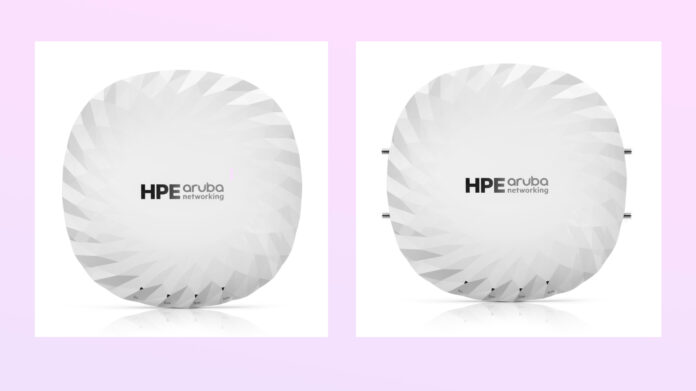Hewlett Packard Enterprise (HPE) has said its new Aruba Wi-Fi 7 access points, out in July, deliver “up to 30 percent” more capacity for wireless traffic compared with standard Wi-Fi 7 gear, courtesy of the firm’s “ultra-tri band hardware technology”. The new 730-series ‘campus APs’ (access points) also do better in terms of network security and location-based positioning, it claims, for demanding enterprise AI and IoT projects.
HPE’s ultra tri-band (UTB) hardware technology “fully utilises” the 5GHz and 6GHz bands to automatically and continuously eliminate wasteful contention between the bands, the company said in a statement. UTB “filtering” eliminates channel interference on adjacent channels in 5GHz and 6GHz bands, said HPE, and this way allows enterprises to use both bands simultaneously, and to improve performance and capacity.
The 30-percent claim, about higher traffic capacity (delivering “the highest on the market”), is measured against the Wi-Fi 7 standard.
Combined with the HPE’s Aruba Networking Central management platform, the new 730-series units work as an “intelligent IoT hub”, said HPE. The combination eliminates the need to deploy “high-overhead vendor-specific” IoT overlay networks to allow the Wi-Fi 7 access points to act as connectors and edge compute elements for IoT devices to communicate directly with third-party IoT services. They have built-in hardware for a range of IoT protocols.
This includes dedicated Bluetooth and Zigbee radios for high-density IoT environments, and dual USB ports for IoT devices using proprietary protocols. HPE said the “integrated, non-permanent” external antennas on the 730-series are designed for challenging radio frequency (RF) environments. They provide higher security for the rush of new IoT devices at the network edge – such as cameras, motor sensors, energy sensors, and motion detectors.
HPE has added policy-based access control and Layer 7 application firewalls, to go with its Client Insights IoT visibility and Dynamic Segmentation role-based access controls on Aruba Networking Central. Additional features include new link level encryption capabilities, which extend wired data protection to the unit, and a personal wireless network mode for secure, self-service onboarding of user devices in group environments.
HPE said they are ready-integrated with over 350 technology partners – to capture, secure, transport IoT data. The Wi-Fi 7 units also feature twice as much SDRAM and Flash memory as previous HPE models to support application-specific containers – for “streamlined data transmissions and local processing of data”. As well, HPE claims improved Wi-Fi positioning, to an accuracy of one metre, with support for the IEEE 802.11az standard.
This is for real-time, immersive, and industrial use cases, it said. They also come with a GNSS satellite receiver, a barometric sensor for floor-level mapping, and a bi-directional Bluetooth Low Energy (BLE) radio for IoT tracking data. HPE said: “Our Wi-Fi 7 APs… become an intelligent IoT hub, securing the network, distributing the workload, characterising the environment, and providing a foundation for business and operational analytics.”

